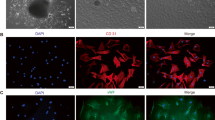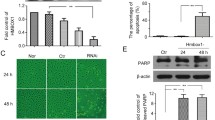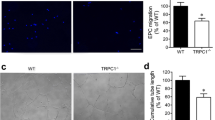Abstract
Studies have demonstrated that the high-mobility group 1B protein (HMGB1) could regulate endothelial progenitor cell (EPC) homing, but the effect of HMGB1 on EPC apoptosis and associated mechanisms are still unclear. The aim of this study was to investigate the effects of HMGB1 on EPC apoptosis and the possible involvement of the endoplasmic reticulum (ER) stress pathway. EPC apoptosis was determined by flow cytometry. The expressions of PERK, eIF2α, and CHOP were detected by western blotting. Additionally, the effects of PERK shRNA on the biological behaviors of EPCs were assessed. Our results showed that incubation of EPCs with HMGB1 (0.1–1 μg/ml) for 12–48 h induced apoptosis as well as activated ER stress transducers, as assessed by up-regulating PERK protein expression and eIF2α phosphorylation in a dose or time-dependent manner. Moreover, HMGB1-mediated EPC apoptosis and CHOP expression were dramatically suppressed by PERK shRNA or a specific eIF2α inhibitor (salubrinal). Importantly, a blocking antibody specifically targeted against RAGE (anti-RAGE antibody) markedly inhibited HMGB1-induced EPC apoptosis and ER stress marker protein (PERK, eIF2α, and CHOP) expression levels. Our novel findings suggest that HMGB1 triggered EPC apoptosis in a manner of RAGE-mediated activation of the PERK/eIF2α pathway.





Similar content being viewed by others
References
Ruan C, Shen Y, Chen R, Wang Z, Li J, Jiang Y (2013) Endothelial progenitor cells and atherosclerosis. Front Biosci (Landmark 18:1194–1201
Lin CP, Lin FY, Huang PH, Chen YL, Chen WC, Chen HY, Huang YC, Liao WL, Huang HC, Liu PL, Chen YH (2013) Endothelial progenitor cell dysfunction in cardiovascular diseases: role of reactive oxygen species and inflammation. Biomed Res Int 2013:845037
Du F, Zhou J, Gong R, Huang X, Pansuria M, Virtue A, Li X, Wang H, Yang XF (2012) Endothelial progenitor cells in atherosclerosis. Front Biosci (Landmark 17:2327–2349
Werner N, Kosiol S, Schiegl T, Ahlers P, Walenta K, Link A, Böhm M, Nickenig G (2005) Circulating endothelial progenitor cells and cardiovascular outcomes. N Engl J Med 353(10):999–1007
Peplow PV (2014) Influence of growth factors and cytokines on angiogenic function of endothelial progenitor cells: a review of in vitro human studies. Growth Factors 32(3–4):83–116
Chiang CH, Huang PH, Chiu CC, Hsu CY, Leu HB, Huang CC, Chen JW, Lin SJ (2014) Reduction of circulating endothelial progenitor cell level is associated with contrast-induced nephropathy in patients undergoing percutaneous coronary and peripheral interventions. PLoS One 9(3):e89942
Du G, Song Y, Zhang T, Ma L, Bian N, Chen X, Feng J, Chang Q, Li Z (2014) Simvastatin attenuates TNF–α–induced apoptosis in endothelial progenitor cells via the upregulation of SIRT1. Int J Mol Med 34(1):177–182
Asavarut P, Zhao H, Gu J, Ma D (2013) The role of HMGB1 in inflammation-mediated organ injury. Acta Anaesthesiol Taiwan 51(1):28–33
Mitola S, Belleri M, Urbinati C, Coltrini D, Sparatore B, Pedrazzi M, Melloni E, Presta M (2006) Cutting edge: extracellular high mobility group box-1 protein is a proangiogenic cytokine. J Immunol 176(1):12–15
Hayakawa K, Pham LD, Katusic ZS, Arai K, Lo EH (2012) Astrocytic high-mobility group box 1 promotes endothelial progenitor cell-mediated neurovascular remodeling during stroke recovery. Proc Natl Acad Sci U S A 109(19):7505–7510
Meng E, Guo Z, Wang H, Jin J, Wang J, Wang H, Wu C, Wang L (2008) High mobility group box 1 protein inhibits the proliferation of human mesenchymal stem cells and promotes their migration and differentiation along osteoblastic pathway. Stem Cells Dev 17(4):805–813
Kaufman RJ (2002) Orchestrating the unfolded protein response in health and disease. J Clin Invest 110(10):1389–1398
Kim I, Xu W, Reed JC (2008) Cell death and endoplasmic reticulum stress: disease relevance and therapeutic opportunities. Nat Rev Drug Discov 7(12):1013–1030
Rutkowski DT, Kaufman RJ (2004) A trip to the ER: coping with stress. Trends Cell Biol 14(1):20–28
Minamino T, Kitakaze M (2010) ER stress in cardiovascular disease. J Mol Cell Cardiol 48(6):1105–1110
Iurlaro R, Muñoz-Pinedo C (2016) Cell death induced by endoplasmic reticulum stress. FEBS J 283(14):2640–2652
Marciniak SJ, Yun CY, Oyadomari S, Novoa I, Zhang Y, Jungreis R, Nagata K, Harding HP, Ron D (2004) CHOP induces death by promoting protein synthesis and oxidation in the stressed endoplasmic reticulum. Genes Dev 18(24):3066–3077
Zheng H, Fu G, Dai T, Huang H (2007) Migration of endothelial progenitor cells mediated by stromal cell-derived factor-1alpha/CXCR4 via PI3K/Akt/eNOS signal transduction pathway. J Cardiovasc Pharmacol 50(3):274–280
Chen J, Song M, Yu S, Gao P, Yu Y, Wang H, Huang L (2010) Advanced glycation endproducts alter functions and promote apoptosis in endothelial progenitor cells through receptor for advanced glycation endproducts mediate overpression of cell oxidant stress. Mol Cell Biochem 335(1–2):137–146
Rouschop KM, van den Beucken T, Dubois L, Niessen H, Bussink J, Savelkouls K, Keulers T, Mujcic H, Landuyt W, Voncken JW, Lambin P, van der Kogel AJ, Koritzinsky M, Wouters BG (2010) The unfolded protein response protects human tumor cells during hypoxia through regulation of the autophagy genes MAP1LC3B and ATG5. J Clin Invest 120(1):127–141
Zhang M, Malik AB, Rehman J (2014) Endothelial progenitor cells and vascular repair. Curr Opin Hematol 21(3):224–228
Dzau VJ, Gnecchi M, Pachori AS, Morello F, Melo LG (2005) Therapeutic potential of endothelial progenitor cells in cardiovascular diseases. Hypertension 46(1):7–18
Edelberg JM, Tang L, Hattori K, Lyden D, Rafii S (2002) Young adult bone marrow-derived endothelial precursor cells restore aging-impaired cardiac angiogenic function. Circ Res 90(10):E89–E93
Aragona CO, Imbalzano E, Mamone F, Cairo V, Lo Gullo A, D’Ascola A, Sardo MA, Scuruchi M, Basile G, Saitta A, Mandraffino G (2016) Endothelial progenitor cells for diagnosis and prognosis in cardiovascular disease. Stem Cells Int 2016:8043792
Malhotra JD, Kaufman RJ (2011) ER stress and its functional link to mitochondria: role in cell survival and death. Cold Spring Harb Perspect Biol 3(9):a004424
Rouhiainen A, Kuja-Panula J, Tumova S, Rauvala H (2013) RAGE-mediated cell signaling. Methods Mol Biol 963:239–263
Xie J, Méndez JD, Méndez-Valenzuela V, Aguilar-Hernández MM (2013) Cellular signalling of the receptor for advanced glycation end products (RAGE). Cell Signal 25(11):2185–2197
Chavakis E, Hain A, Vinci M, Carmona G, Bianchi ME, Vajkoczy P, Zeiher AM, Chavakis T, Dimmeler S (2007) High-mobility group box 1 activates integrin-dependent homing of endothelial progenitor cells. Circ Res 100(2):204–212
Acknowledgements
This study was supported by the National Natural Science Foundation of China (No. 31270992 and No. 81670453) and China Postdoctoral Science Foundation (2015M582350).
Author information
Authors and Affiliations
Corresponding authors
Ethics declarations
Conflict of interest
The authors declare no conflicts of interest.
Additional information
Ji-Peng Zhou and Ying Luo have contributed equally to this work.
Rights and permissions
About this article
Cite this article
Huang, Q., Yang, Z., Zhou, JP. et al. HMGB1 induces endothelial progenitor cells apoptosis via RAGE-dependent PERK/eIF2α pathway. Mol Cell Biochem 431, 67–74 (2017). https://doi.org/10.1007/s11010-017-2976-2
Received:
Accepted:
Published:
Issue Date:
DOI: https://doi.org/10.1007/s11010-017-2976-2




